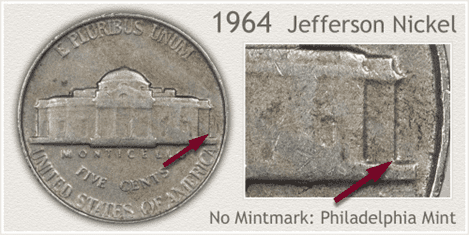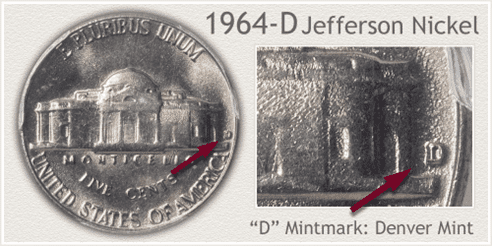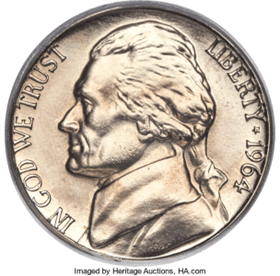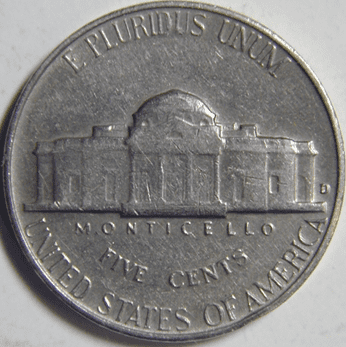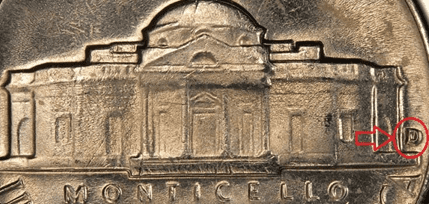What Is The 1964 Jefferson Nickel?
The 1964 Jefferson nickel coin was designed in 1938 by Felix Schlag when it replaced the Indian head nickel. The coin is made of 75% copper and 25% nickel and has a total melt value of $0.0567, it weighs 5 grams and is still used in commerce today.
The obverse side of the 1964 Jefferson Nickel features a left-facing bust of President Thomas Jefferson, which includes a colonial-era pigtail and is near identical in detail to Jean-Antoine Houdon’s 1789 bust.
Starting from Jefferson’s chest and extending to his hairline, the slogan IN GOD WE TRUST–which became the national motto in 1956–arcs clockwise along with most of the left side of the coin.
Behind Jefferson, the letters LIBERTY and 1964 run clockwise around the right side. A little five-pointed star separates the two inscriptions.
A front image of Monticello, Jefferson’s estate near Charlottesville, Virginia, appears on the reverse. The flattened representation loses much of the building’s dimensionality, but the octagonal form of the dome can still be seen, and better strikes expose significant detail in the steps and portico.
The phrase E PLURIBUS UNUM (“Out of Many, One”) appears on the reverse. The name MONTICELLO appears in a straight line directly beneath the structure. The words the UNITED STATES OF AMERICA run counterclockwise down the bottom edge of the coin, and the number FIVE CENTS creates a gently curved line beneath it.
Designer Felix Schlag’s initials did not appear on a Jefferson nickel until 1966, which is interesting.
The Nobel Peace Prize was granted to Dr. Martin Luther King, Jr., and the most violent earthquake in US history struck South Central Alaska in 1964.
Muhammed Ali defeats Sonny Liston for the World Heavyweight Championship, while Elizabeth Taylor marries Richard Burton for the first time.
Do Nickels From 1964 Have Silver?
While many coins up until 1964 did have up to a 90% silver content; such as the half dollar the 1964 nickel doesn’t contain any silver and gets its silver tones from the 25% nickel cladding in its composition.
There are Jefferson nickels which did have a 35% silver content, but these were dated between 1942 and 1945.
1964 Nickel Series
1964 Nickel With No Mint Mark
Year: 1964
Face Value: $0.5c
Composition: 75% copper and 25% nickel
Total Weight: 5 g
Diameter: 21.21 mm (0.835 in)
Thickness: 1.95 mm
Edge: Plain
Minted in: Philadelphia
Quantity Minted: 1,028,622,762

photo source: www.coinstudy.com
1964 D Nickel
Year: 1964
Face Value: $0.5c
Composition: 75% copper and 25% nickel
Total Weight: 5 g
Diameter: 21.21 mm (0.835 in)
Thickness: 1.95 mm
Edge: Plain
Minted in: Denver
Quantity Minted: 1,787,297,160

photo source: www.coinstudy.com
1964 SMS Nickel (Special Strike)

photo source: coins.ha.com
The 1964 SMS nickel is among the rarest of all Jeffersons, and its coinage was unknown to the collecting public for nearly three decades after it was struck.
The first known auction appearance of an example was in Stack’s Public Auction Sale in 1993.
Today, fewer than two dozen 1964 SMS nickels are believed to be known, with a PCGS-certified population of just 19 coins.
1964 ‘Pluridus’ Error

photo source: forums.collectors.com
The motto E PLURIBUS UNUM appears on U.S. coinage. Most people are familiar with it, even if they aren’t sure what it means (it’s a Latin phrase that means “out of many, one,” and it means “out of my states, one nation has been fashioned in this land).
Familiarity, on the other hand, frequently begets inattention. That’s why when 1964-D Jefferson nickels arrived with PLURIBUS misspelt as PLURIDUS, many collectors didn’t notice at first.
The core of the letter “B” had completely erased due to the heavy polishing of one or more dies, resulting in this fascinating defect.
Other Errors
Other 1964 Nickel errors are singular flukes of the manufacturing process, but still are interesting to look at such as the examples below.

photo source: cointrackers.com
The 1964 Nickel Struck on 1C Planchet Error is a reddish-colored penny with a nickel-like appearance.
Then there’s the 1964 Struck By Error, which is a common occurrence. When a foreign object is brought into the minting process, this error occurs. A piece of fabric was lying on the nickel planchet when it was struck in the case of the image attached.
There’s also the 1964 Double Strike Nickel Error, which occurs when the die strikes the planchet two or more times. If the planchet is not properly ejected, the coin will be struck again, and if the error is not detected, then it will be allowed into circulation.
What Is The Value Of A 1964 Nickel?
Due to its lack of precious metal content, the 1964 Nickel only has a melt value of around $0.0567.
The below table indicates the pawnbroker values for standard-issue, ungraded examples of Jefferson nickel.
| Condition | 1964 | 1964 D |
| Uncirculated | $8.91 | $0.63 |
| Extremely Fine | Face Value | Face Value |
| Fine | Face Value | Face Value |
| Good | Face Value | Face Value |
Graded Jefferson Nickels can have a higher value, as evidenced below:
- Grade MS64 = $15-$25
- Grade MS65 = $19-$31
- Grade MS66 = $41-$69
- Grade MS67 = $600-$1,000
- Grade PR64 = $8-$13
- Grade PR65 = $9-$15
- Grade PR66 = $11-$19
- Grade PR67 = $13-$21
- Grade PR68 = $17-$28
- Grade PR69 = $30-$50
- Grade PR70 = $1,238-$2,063
You can assess whether your nickel is worth closer investigation or even grading by exploring the following features:
Look for the following to establish the coin’s value:
- ‘Full Steps’ are coins that have no minting flaws and are in excellent condition.
- Nickels that are uncirculated and show no indications of wear. They also keep their original characteristics.
- Special minting faults, like re-punched mint markings or missing dates, can occur on 1964 nickels.
To put it another way, if your nickel contains five full steps and unique minting mistakes, it will be valued far more than a standard 1964 nickel.
Full Steps
The term “Full Steps” refers to circulation strike Jefferson Nickels with at least five full steps visible at the base of Monticello on the reverse. The label is used to identify coins that have been fully struck in general.
How Does The Grading System Work?
The Sheldon Scale is used by numismatists to provide a numerical value to coins. The Sheldon Scale goes from poor (P-1) to perfect mint state (P-1) (MS-70). Coins were originally evaluated using words to reflect their condition (Good, Fair, Excellent, Etc.). Unfortunately, coin collectors and dealers had different ideas about what each of these terms represent.
Professional numismatists joined together in the 1970s and established CoinGrading standards. These numismatists now assign grades at key places on the seventy-point scale, using the most regularly utilized numeric points in conjunction with the original adjective grade. The following are the most common coin grades:
-
-
- (P-1) Poor – Indistinguishable and probably damaged; if used, must have a date and mintmark; otherwise, rather battered.
- (FR-2) Fair – Nearly smooth, but without the damage that a coin graded Poor often possesses. The coin must have enough detail to be identified.
- (G-4) Fair – Inscriptions have merged into the rims in some areas, and important elements have been mostly erased.
- (VG-8) Very Good- A little weathered, but all of the primary design elements are visible, albeit faintly. There is little if any, central detail left.
- (F-12) Good – The item is very worn, yet the wear is even, and the overall design details stand out clearly. Rims are almost completely isolated from the field.
- (VF-20) Very Fine – Moderately weathered, with some finer features still visible. The motto or all letters of LIBERTY are readable. Both sides of the coin have entire rims that are separated from the field.
- (EF-40) Extremely Fine – Gently used; all gadgets are visible, and the most important ones are bold. The finer details are bold and clear, however, light wear may be seen.
- (AU-50) Uncirculated – Slight evidence of wear on the coin’s design’s high points; may have contact marks; eye appeal should be adequate.
- (AU-58) Uncirculated Choice – Slight traces of wear, no severe contact marks, almost full mint shine, and great eye appeal.
- (MS-60) Mint State Basal – Strictly uncirculated; no indication of wear on the coin’s highest points, but an unsightly coin with reduced luster, visible contact marks, hairlines, and other flaws.
- (MS-63) Mint State Acceptable – Uncirculated, but with contact scratches and nicks, little reduced shine, but otherwise appealing appearance. The strike is weak to average.
- (MS-65) Mint State Choice – Uncirculated with great mint shine, very little contact blemishes, and exceptional eye appeal. The strike is unusually severe.
- (MS-68) Mint State Premium Quality – Uncirculated with superb luster, no obvious contact marks to the naked eye, and exceptional eye appeal. The strike is quick and appealing.
- (MS-69) Almost Perfect Mint State – Uncirculated with perfect brilliance, a sharp and appealing strike, and extremely good eye appeal. A near-perfect coin with minor imperfections in the planchet, strike, and contact markings (seen only under 8x magnification).
- (MS-70) Mint State Perfect – Under 8x magnification, there are no tiny imperfections discernible; the strike is crisp, and the coin is perfectly centered on a beautiful planchet. Rarely seen on a coin, this coin is bright and whole, with original luster and exceptional eye appeal.
-
What Is The Rarest 1964 Nickel?
There is a wide variety of sought-after 1964 Jefferson nickels, and here’s a rundown of some of the most valuable examples:
1964 SMS FS (SP68 FS): Sold for $32,900
This FS kind (excellent minting and preservation of President Jefferson’s residential building’s entrance stairs on the back) is extremely rare.
The highest valuation for the SP68 graduation (7 copies listed in PCGS) was $32,900 in 2016, and another SP68 copy was auctioned for $17,625 in the same auction.
1964 FS (MS67): Sold for $14,100
Despite the fact that over one billion were produced in Philadelphia, obtaining a copy of the FS (“Full Steps”), which is extremely valuable and sought after, is quite difficult.
In 2014, a new valuation record of $14,100 was set in MS67 quality.
Other MS67 specimens have sold for somewhere between $8,519 and $9,400. Their auction prices have ranged from $750 to $2,585 in MS66+ condition, and from $264 to $3,525 in MS66.
1964-D FS (MS66): Sold for $6,325
An MS66 copy was auctioned in 2009 for $6,325, and prices for this graduation have not topped $3,995 since then.
964-D/D (MS65): Sold for $4,015

photo source: www.coleccionistasdemonedas.com
The reverse of a 1964-D Jefferson Nickel variant has a very obvious double minting that is plainly visible to the naked eye – for example, at the mint mark.
The highest price for this variety was $4,015, which was achieved in 2014 when an MS65 was auctioned. Another specimen with the same graduation was later closed in 2016 for $2,820.
Where To Buy Or Sell 1964 Nickels?
Nickels from 1964 can be bought and traded in a variety of ways. You might even find one or two in your pocket change because they’re still in circulation.
Of course, for basic, circulated coins, eBay and Etsy are excellent sources.
If you’re new to coin collecting and think you might have a rare 1964 Nickel like the ones described above, it’s always best to be safe than sorry and get your coin evaluated by an in-person or online professional.
FAQs
How much is a 1964 doubled die nickel worth?
As you know, the valuation of coins is very subjective and prices can swing from high to low based on the smallest of details. The highest value recorded for a 1964 D/D nickel is $4,015.
Are nickels worth more melted down?
The 1964 Jefferson Nickel has a melt value of $0.0567, which is less than a cent over its face value, so melting down these coins is more money than it’s worth.
How much is the 1964 Jefferson nickel at the pawnshop?
Outside of uncirculated coins, which can be worth a few bucks, most 1964 nickels are only worth their face value when sold at pawnshops.
How do you identify a 1964 SMS nickel?
The Special Strike of 1964 Jefferson Nickels is known for having a very sharp strike as well as sharp and square edge rims. In general, the overall quality and clarity of the strike are greater than standardly struck coins.

